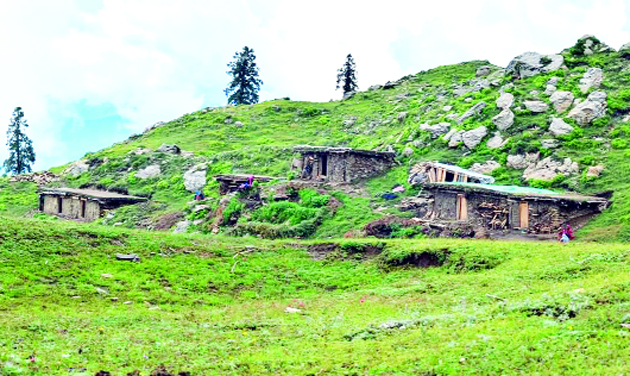Sadaket Malik
Bhalessa in Doda has a vast potential in the tourism industry. In Bhatyas of chilly pingal Tehsil, of Doda, lies Gasheer Top, a historical splendor waiting to share its tales with those willing to listen. The journey begins not just with the physical exploration of this enchanting dhok but with the whispers of its presence in the Takri records-a silent invitation to uncover the mysteries held within its snow-clad embrace.
The place enjoys a whispering Takri Records. Gasheer Top’s story unfolds in the subtle strokes of the Takri records, an ancient script that serves as a bridge between the past and the present. As one delves into these records, fragments of a forgotten narrative emerge, painting a vivid picture of a place that time forgot. The historical significance of Gasheer Top becomes a compelling reason to embark on a journey of discovery.
As the traveler approaches Gasheer Top, the landscape transforms into a mesmerizing canvas. Jakyas, Chanyas, Gondow, and Budhli, neighboring areas, weave together a tapestry of natural beauty. The dhok, carpeted with pristine snow, stands as a tranquil structure, beckoning adventurers and nature enthusiasts alike to witness its beauty.
In the echoes of time, the Takri records reveal a rich tapestry of history, weaving tales of antiquities in Bhalessa. Among these, Nooran Gowari and Gashir Top stand as enigmatic markers, their present-day pronunciations-Nora Gowari and Gasheer Top-hinting at a journey through the ages, the Archieves Department record reveal the presence of it in the Takri record.
According to the historical records, Labh Joo Kardar of Bhalessa played a pivotal role in the leasing out of these two Dhars, Gasheer Top and Nooran Gowari. In the annals of history, it is believed that this transaction occurred during Maharaja Ranbir Singh’s reign, adding layers of significance to these places.
The pasture lands, bestowed by Piar Singh Kardar of Bahaderwah Pargana to Laj Singh Kardar of Bhalessa Pargana, formed the backdrop for Labh Joo’s actions. Subsequently, Dido Jugani, a prominent figure in the archives of Counsy Lanmu, became a custodian of these lands, as evidenced by a Patta dated 6th Sawan Samvat 1915, corresponding to July 18th, 1858 A.D.
Labh Joo’s Patta, a document of historical relevance, sheds light on the leasing of Gasheer Top. The recipients of this lease, Rani Gagan and Basya Thakkar of Pingal, were entrusted with the responsibility of these lands. The lease money, initially set at Rs. 70, underwent an increase, bringing it to Rs. 84. The Sirkar, indicating the ruling authority, was entitled to recover this amount along with grazing dues.
As the translation of Labh Joo’s Patta unfolds, it becomes evident that the leasing of this place was a meticulously observed process. The responsibility entrusted to Rani Gagan and Basya Thakkar underscores the significance of these lands, not merely as geographic entities but as custodians of a historical legacy.
In the records of Labh Joo Kardar of Bhalessa, Noran Gowari and Gasheer Top continue to echo with the whispers of their past, their stories embedded in the very soil that has witnessed centuries of change. These antiquities, mentioned in the takri records, serve as a testament to the intricate dance of history, culture, and governance in the picturesque land of Bhalessa.
The place truly comes alive in winter-a wonderland draped in snow, reflecting the purity of its untouched surroundings. The cold breeze carries tales of the past, creating an atmosphere of serenity. The air is filled with the promise of adventure, inviting mountaineers and trekkers to explore its untamed beauty.
This hotspot with its untapped potential, holds the key to economic prosperity for the region. However, the journey towards realizing this potential requires the creation of essential tourist infrastructure. The call for tourist huts and improved road connectivity becomes a chorus echoing through the valleys, urging development that harmonizes with nature.
Gasheer top isn’t just a destination; it is a catalyst for transforming Bhalessa into an adventure hub. Amidst the three tehsils of Gandoh, Chilly Pingal, and Kahara, this dhok adds vibrant hues to the canvas of Bhalessa’s adventurous spirit. It is a place where history meets nature, creating a unique blend that captivates the soul.
As it celebrates its place in history, a vision for the future takes shape. It is a future where tourists, guided by the whispers of Takri records, embark on a journey to Gasheer Top, a place where history and nature dance hand in hand. The development envisioned, marked by tourist huts and improved link road connectivity, becomes imperative to the commitment of embracing the past while paving the way for a vibrant future.
Gasheer Top not only has a historical significance and breathtaking landscapes but also emerges as a haven for diverse avian species. Among its feathered inhabitants are migratory birds such as Nail and Gur Kako, adding a dynamic and vibrant dimension to its natural allure. The presence of Shaheen further enhances Gasheer Top’s reputation as a hotspot for birdwatchers, providing a unique opportunity to witness these majestic creatures in their natural habitat. The harmonious coexistence of history, nature, and wildlife makes Gasheer Top a truly enchanting destination for those seeking a rich and immersive experience.
Gasheer Top awaits, ready to share its story with those who dare to venture into its snow-clad realm-a journey that transcends time and leaves an indelible mark on the souls of those who embark upon it. The Government needs to identify this place and bring it under the ambit of the state tourism policy.
Trending Now
E-Paper


